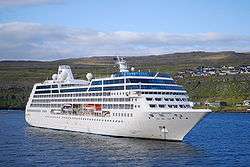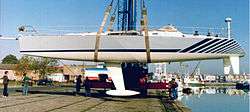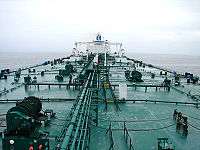Naval architecture

Naval architecture also known as naval engineering, is an engineering discipline dealing with the engineering design process, shipbuilding, maintenance, and operation of marine vessels and structures.[1][2] Naval architecture involves basic and applied research, design, development, design evaluation and calculations during all stages of the life of a marine vehicle. Preliminary design of the vessel, its detailed design, construction, trials, operation and maintenance, launching and dry-docking are the main activities involved. Ship design calculations are also required for ships being modified (by means of conversion, rebuilding, modernization, or repair). Naval architecture also involves formulation of safety regulations and damage control rules and the approval and certification of ship designs to meet statutory and non-statutory requirements.

Main subjects
The word "vessel" includes every description of watercraft, including non-displacement craft, WIG craft and seaplanes, used or capable of being used as a means of transportation on water.[3] The principal elements of naval architecture are:[4]
Hydrostatics

Hydrostatics concerns the conditions to which the vessel is subjected to while at rest in water and its ability to remain afloat. This involves computing buoyancy, (displacement) and other hydrostatic properties, such as trim (the measure of the longitudinal inclination of the vessel) and stability (the ability of a vessel to restore itself to an upright position after being inclined by wind, sea, or loading conditions).[5]
Hydrodynamics
Hydrodynamics concerns the flow of water around the ship's hull, bow, and stern, and over bodies such as propeller blades or rudder, or through thruster tunnels. Resistance – resistance towards motion in water primarily caused due to flow of water around the hull. Powering calculation is done based on this. Propulsion – to move the vessel through water using propellers, thrusters, water jets, sails etc. Engine types are mainly internal combustion. Some vessels are electrically powered using nuclear or solar energy. Ship motions – involves motions of the vessel in seaway and its responses in waves and wind. Controllability (maneuvering) – involves controlling and maintaining position and direction of the vessel

Structures
Structures involves selection of material of construction, structural analysis of global and local strength of the vessel, vibration of the structural components and structural responses of the vessel during motions in seaway.
Arrangements
Arrangements involves concept design, layout and access, fire protection, allocation of spaces, ergonomics and capacity.
Construction
Construction depends on the material used. When steel or aluminium is used this involves welding of the plates and profiles after rolling, marking, cutting and bending as per the structural design drawings or models, followed by erection and launching. Other joining techniques are used for other materials like fibre reinforced plastic and glass-reinforced plastic.
Science and craft
_arrives_at_Naval_Station_Pearl_Harbor_to_participate_in_Rim_of_the_Pacific_(RIMPAC)_2008.jpg)
Traditionally, naval architecture has been more craft than science. The suitability of a vessel's shape was judged by looking at a half-model of a vessel or a prototype. Ungainly shapes or abrupt transitions were frowned on as being flawed. This included rigging, deck arrangements, and even fixtures. Subjective descriptors such as ungainly, full, and fine were used as a substitute for the more precise terms used today. A vessel was, and still is described as having a ‘fair’ shape. The term ‘fair’ is meant to denote not only a smooth transition from fore to aft but also a shape that was ‘right.’ Determining what is ‘right’ in a particular situation in the absence of definitive supporting analysis encompasses the art of naval architecture to this day.
Modern low-cost digital computers and dedicated software, combined with extensive research to correlate full-scale, towing tank and computational data, have enabled naval architects to more accurately predict the performance of a marine vehicle. These tools are used for static stability (intact and damaged), dynamic stability, resistance, powering, hull development, structural analysis, green water modelling, and slamming analysis. Data is regularly shared in international conferences sponsored by RINA, Society of Naval Architects and Marine Engineers (SNAME) and others. Computational Fluid Dynamics is being applied to predict the response of a floating body in a random sea.
The naval architect
Due to the complexity associated with operating in a marine environment, naval architecture is a co-operative effort between groups of technically skilled individuals who are specialists in particular fields, often coordinated by a lead naval architect.[6] This inherent complexity also means that the analytical tools available are much less evolved than those for designing aircraft, cars and even spacecraft. This is due primarily to the paucity of data on the environment the marine vehicle is required to work in and the complexity of the interaction of waves and wind on a marine structure.
A naval architect is an engineer who is responsible for the design, construction, and/or repair of ships, boats, other marine vessels, and offshore structures, both commercial and military, including:
- Merchant ships – oil tankers, gas tankers, cargo ships, bulk carriers, container ships
- Passenger/vehicle ferries, cruise ships
- Warships – frigates, destroyers, aircraft carriers, amphibious ships
- Submarines and underwater vehicles
- Icebreakers
- High speed craft – hovercraft, multi-hull ships, hydrofoil craft
- Workboats – barges, fishing boats, anchor handling tug supply vessels, platform supply vessels, tug boats, pilot vessels, rescue craft
- Yachts, power boats, and other recreational watercraft
- Offshore platforms and subsea developments
Some of these vessels are amongst the largest (such as supertankers), most complex (such as Aircraft carriers), and highly valued movable structures produced by mankind. They are typically the most efficient method of transporting the world's raw materials and products. Modern engineering on this scale is essentially a team activity conducted by specialists in their respective fields and disciplines. Naval architects integrate these activities. This demanding leadership role requires managerial qualities and the ability to bring together the often-conflicting demands of the various design constraints to produce a product which is fit for the purpose.[7]
In addition to this leadership role, a naval architect also has a specialist function in ensuring that a safe, economic, environmentally sound and seaworthy design is produced. To undertake all these tasks, a naval architect must have an understanding of many branches of engineering and must be in the forefront of high technology areas. He or she must be able to effectively utilize the services provided by scientists, lawyers, accountants, and business people of many kinds.
Naval architects typically work for shipyards, ship owners, design firms and consultancies, equipment manufacturers, Classification societies, regulatory bodies (Admiralty law), navies, and governments.
See also
| Wikimedia Commons has media related to Naval architecture. |
References
- ↑ RINA – Careers in Naval Architecture
- ↑ Biran, Adrian; (2003). Ship hydrostatics and stability (1st Ed.) – Butterworth-Heinemann. ISBN 0-7506-4988-7
- ↑ Convention On The International Regulations for Preventing Collisions at Sea, 1972,As Amended; International Maritime Organization; ISBN 92-801-4167-8
- ↑ Lewis V, Edward (Ed.); (June 1989). Principles of Naval Architecture (2nd Rev.) Vol. 1 – Society of Naval Architects and Marine Engineers. ISBN 0-939773-00-7
- ↑ www.usna.edu
- ↑ American Society of Naval Engineers Archived December 26, 2008, at the Wayback Machine.. Naval engineering brochure.
- ↑ "Job Family Standard for Professional Work in the Engineering and Architecture Group, U.S. Office of Personnel Management, pp. 43–45" (PDF). Archived from the original (PDF) on 2009-05-12.
External links
![]() Media related to Naval architecture at Wikimedia Commons
Media related to Naval architecture at Wikimedia Commons
- Ferreiro, Larrie D. (2007). Ships and Science: The Birth of Naval Architecture in the Scientific Revolution, 1600-1800. MIT Press. ISBN 978-0-262-06259-6.
- Paasch, H. Dictionary of Naval Terms, from Keel to Truck: English, French, German, Spanish, Italian. Fourth ed., rev. and enl. London: G. Philip & Son, 1908, cop. 1905. 803 + 109 oblong p. + extensive unpaged indices.